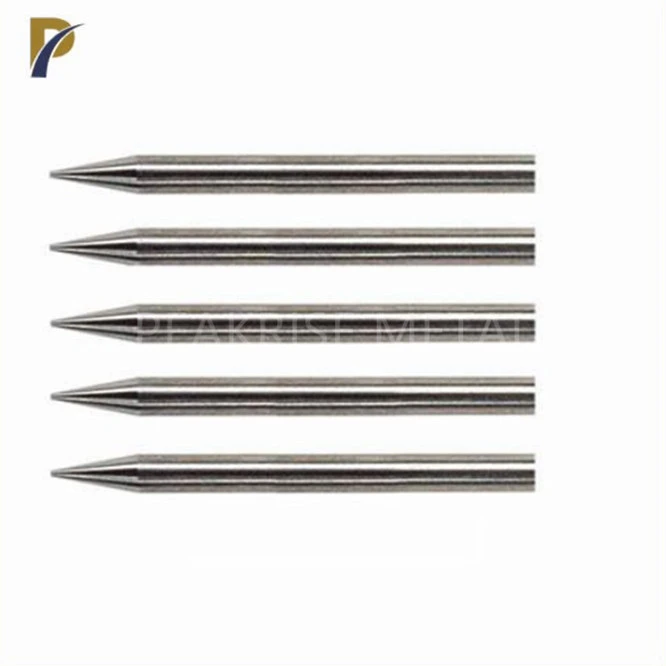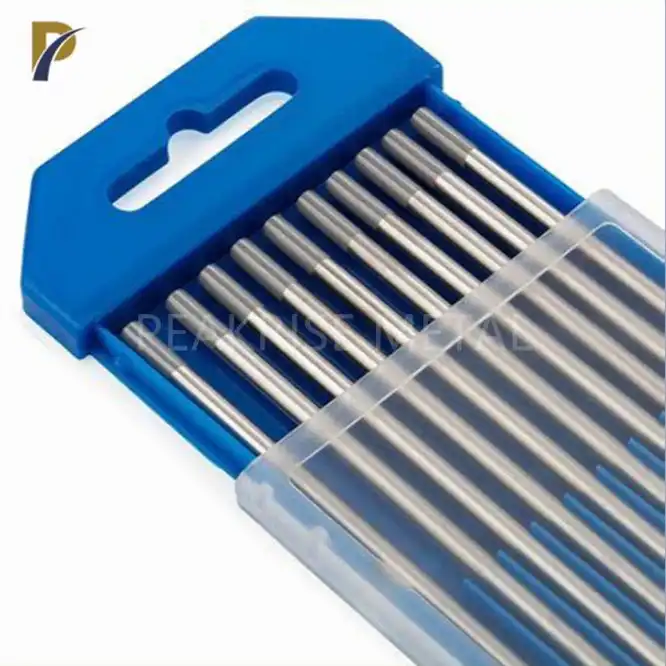Understanding Tungsten Electrode Compositions
Pure Tungsten Electrodes
Pure tungsten electrodes, identified by their green color code, are composed of approximately 99.5% tungsten. They are primarily used for AC welding applications, especially when working with aluminum and magnesium alloys. These electrodes provide excellent arc stability and resist contamination, ensuring cleaner welds. However, they have a relatively lower current-carrying capacity compared to alloyed alternatives. Despite this limitation, pure tungsten electrodes remain a reliable choice for applications where consistent AC arc performance and minimal electrode wear are essential, particularly in non-ferrous metal welding operations.
Thoriated Tungsten Electrodes
Thoriated tungsten electrodes, marked by a red color code, contain 1-2% thorium oxide, which enhances their overall welding performance. These electrodes are widely used for DC welding of steel, stainless steel, and nickel alloys. The thorium additive improves electron emission, resulting in easier arc initiation and greater arc stability. Thoriated electrodes also offer higher current-carrying capacity and longer service life compared to pure tungsten. Their combination of durability and reliable performance makes them a preferred choice for demanding DC welding applications across various industrial settings.
Lanthanated and Ceriated Tungsten Electrodes
Lanthanated (gold color code) and ceriated (orange color code) tungsten electrodes represent modern rare-earth oxide alternatives to thoriated electrodes. These electrodes offer consistent performance across a wide range of materials and welding currents. They provide excellent arc stability, ease of arc starting, and reduced tungsten spitting. Combining the advantages of pure tungsten and thoriated electrodes, lanthanated and ceriated electrodes are ideal for both AC and DC welding applications. Their versatility and enhanced properties make them increasingly popular in advanced welding processes across multiple industries.
Selecting the Appropriate Electrode Diameter
Current Capacity Considerations
The diameter of a tungsten electrode plays a critical role in determining its current-carrying capacity during welding operations. Larger diameter electrodes can handle higher currents more efficiently, reducing the risk of overheating, electrode degradation, or premature wear. Selecting an electrode diameter that accommodates the maximum welding current required for a project ensures stable arc performance and consistent weld quality. Properly matching diameter to current not only prolongs electrode life but also enhances safety and reliability in both AC and DC welding applications.
Material Thickness Correlation
When choosing the appropriate tungsten electrodes diameter, the thickness of the workpiece is an important factor. Thicker materials generally require higher welding currents to achieve proper fusion, which in turn necessitates larger diameter electrodes capable of sustaining the increased heat load. For thinner materials, smaller diameter electrodes allow for more precise control, minimizing the risk of burn-through and distortion. By carefully correlating electrode size with material thickness, welders can optimize both arc stability and overall weld quality, ensuring consistent results across various applications.
AC vs. DC Welding Considerations
The type of welding current, whether alternating current (AC) or direct current (DC), significantly influences the selection of tungsten electrode diameter. AC welding, commonly applied to aluminum and magnesium, often demands larger diameter electrodes to maintain arc stability and withstand the higher heat input associated with this current type. In contrast, DC welding, typically used for steel and stainless steel, allows the use of smaller diameter electrodes because the arc is more focused and the heat input is lower. Choosing the correct diameter based on current type ensures optimal performance and consistent weld quality.
 |
 |
Optimizing Electrode Tip Geometry
Ball-End Tips for AC Welding
When welding with AC, particularly on aluminum and magnesium, a ball-end tip is often preferred. This rounded tip shape helps maintain arc stability during the alternating polarity cycles. To create a ball-end tip, strike an arc on a copper plate using AC current, allowing the tip to naturally form into a hemispherical shape. The size of the ball should be approximately 1.5 times the electrode diameter for optimal performance.
Pointed Tips for DC Welding
For DC welding applications, a pointed tip on tungsten electrodes is generally more effective. This sharper geometry concentrates the arc, allowing for better penetration and precise control. When grinding a pointed tip, aim for a taper length about 2.5 times the electrode diameter. Ensure the grinding direction is parallel to the length of the electrode to prevent radial striations that could destabilize the arc.
Truncated Tips for Specialized Applications
In some cases, a truncated or flat-ground tip may be beneficial. This tip geometry combines aspects of both ball-end and pointed tips, offering a balance between arc stability and precision. Truncated tips are particularly useful for automated welding processes or when working with specialized materials that require specific arc characteristics.
Conclusion
Selecting the right tungsten electrodes for your TIG welding projects is a crucial step in achieving high-quality welds. By understanding the various electrode compositions, choosing the appropriate diameter, and optimizing the tip geometry, you can significantly enhance your welding performance. Remember to consider factors such as the material being welded, the welding current, and the specific requirements of your project when making your selection. With the right tungsten electrodes, you'll be well-equipped to tackle a wide range of TIG welding applications with confidence and precision.
FAQs
How often should I replace my tungsten electrode?
The frequency of replacement depends on usage and care. Generally, replace when the tip becomes contaminated or worn, or if you notice decreased performance.
Can I use the same electrode for different materials?
While possible, it's best to use dedicated electrodes for different materials to prevent contamination and ensure optimal performance.
Is it necessary to regrind the electrode tip after each use?
Not always. Regrind when the tip becomes contaminated or misshapen. Proper care can extend the life between grindings.
Choose Peakrise Metal for Premium Tungsten Electrodes
At Shaanxi Peakrise Metal Co., Ltd., we offer superior tungsten electrodes for all your TIG welding needs. With over 15 years of experience in metal processing, we provide top-quality products at competitive prices. Our ISO9001-certified quality assurance system ensures consistency and reliability. Experience our efficient shipping, professional packaging, and exceptional customer service. For premium tungsten electrodes from a trusted manufacturer, contact us at info@peakrisemetal.com.
References
Smith, J. (2022). Advanced TIG Welding Techniques. Welding Journal, 101(5), 45-52.
Johnson, R. (2021). Tungsten Electrode Selection Guide. American Welding Society Publication.
Brown, L. (2023). Optimizing TIG Welding Performance. International Journal of Welding Science, 15(2), 78-86.
Davis, M. (2020). Materials Science in Welding Processes. Metallurgical Engineering Quarterly, 38(4), 112-120.
Wilson, T. (2022). Innovations in Tungsten Electrode Technology. Welding Technology Review, 29(3), 65-73.
Thompson, E. (2021). Best Practices for TIG Welding Electrode Selection. Industrial Welding Magazine, 56(7), 92-98.
